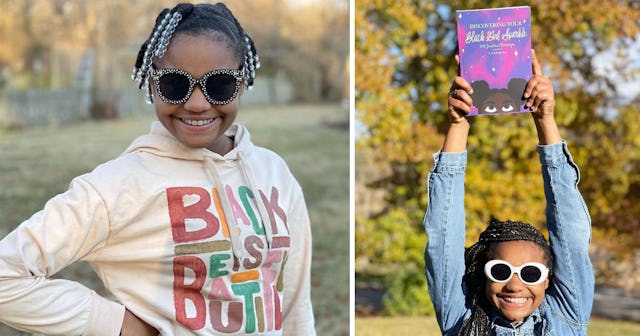My Teen Wrote A Book To Help Fellow Black Girls Discover Their Sparkle

Toni Morrison once shared, “If there’s a book that you want to read, but it hasn’t been written yet, then you must write it.” This is exactly what my teen daughter recently did. After she couldn’t find a journal specific to Black teen girls like herself, she decided to write one. Her book is called Discovering Your Black Girl Magic: 100 Journal Prompts. Now, it’s available to Black, teen girls everywhere.
My girl is no stranger to writing. After all, I’m a writer. My kids have grown up watching me pour my heart, time, and energy into composing hundreds of articles, publishing a few books, and participating in media interviews. They’ve sat with me in green rooms and read my work over my shoulder. Writing is definitely part of our family vibe.
My kids love to read and write, which makes my mama heart so happy. However, for too long, until fairly recently, there hasn’t been many options featuring characters who look like them. Black people are grossly underrepresented in publishing due to systemic racism—not due to a lack of talented creators. When my kids did find books that featured themselves, the narratives were often limited to slavery and civil rights—Black trauma. Those books were also often and unsurprisingly written by white people.
We are very thankful that more and more Black authors and illustrators are taking center stage and telling their own stories. My daughter has now joined their ranks, and it’s downright magical to watch her shine in this way, especially as a new 13-year-old.
My kids have learned from me that when you have a gift, you can keep it to yourself or you can share it with the world. It’s our choice. Sharing requires risk and vulnerability. There’s always the risk of rejection and criticism. However, keeping your gift for yourself doesn’t have the same impact as sharing it.
This year, my daughter has been quietly and diligently working on her book—on weekends, on holidays, and in the evenings. She’s been through the nuances of writing a book—drafting, drafting, drafting. Tossing pieces of paper in the recycle bin, growing frustrated and tired, and facing the ever-dreaded writer’s block. We’ve printed, made notes, revised, and printed again. She’s learned the art of sipping coffee and rubbing her red eyes as we pushed forward, sentence by sentence and page by page.
I think about how it’s been such an incredible past few years for Black creators and for those who get to enjoy their work. When I was a child, I remember seeing Rodgers and Hammerstein’s Cinderella on a Friday night—the one starring Brandy, Whitney Houston, and Whoopi Goldberg. Seeing a Black Cinderella was revolutionary at the time, and Tiana wouldn’t come along for many years after.
Now, there is representation everywhere—on every streaming channel, on bookshelves, in movie theaters, in art, and even during this holiday season, on wrapping paper and ornaments. My preschoolers is obsessed with watching “Karma’s World” on Netflix, a show starring a Black girl who has some catchy musical talent. My kids can’t get enough of “Family Reunion,” also on Netflix, a show about an all-Black family and their adventures. My kids devour books. My teen’s favorites are by Jaqueline Woodson, Brandy Colbert, Jewell Parker Rhodes, and Renee Watson. I can’t tell you how many times we’ve watched “Black Panther,” but I will tell you that when posing for Christmas pics, one kiddo crossed her arms across her chest, Wakanda Forever style. When “Jingle Jangle” released last Christmas, my kids watched it on repeat. The all-Black cast mesmerized them. Accessing Black-created and Black-protagonist resources is absolutely everything.
There’s a constant influx of new and incredible Black representation. We can’t get enough. Though there used to be void, a lack of artistic creations accessible to the masses, this is no longer the case. My daughter can now call herself a creator, having produced a book that will make its way into Black girl teens during this upcoming holiday season—and beyond.
She wrote 100 journal prompts, ranging from a teen’s likes and dislikes, favorite memories, poignant moments, favorites, and much more. There’s also pages for free drawing or writing. Some prompts encourage girls to create or invent, while others simply ask them to reflect on a life event. The book encourages girls to slow down and empower themselves in a culture that values rapid change and instant gratifications.
My daughter also prompts her readers to reflect on social issues, particularly racism and racial equity. She also shares quotes from well-known women, asking her readers to consider their wisdom. Page after page is a mixture of self-love, consideration, and creativity.
I’m not sure she’ll grasp the magnitude of her contribution until she’s a bit older. However, I know she’ll look back and realize how incredibly brave she was to say yes to this adventure. Putting words on paper, pouring over each and every one of them for months, and then releasing those words to the world is courageous — the epitome of the Black girl sparkle she’s inspiring in other Black teens.
When you’re a writer, your words reach so far beyond what and whom you can possibly imagine. Writing a book is a way of making a difference in a world that can be so indifferent, especially to the struggles and challenges that Black girls often face. Though the media stereotypes Black girls as street-smart, angry, loud, and bossy, Discovering Your Black Girl Sparkle claps back at that. Black girls, as my daughter shares, need to be free to be who they are. They also need the time and space to change, to reflect, and to be proud of themselves.
My daughter is embodying Ms. Morrison’s wisdom: She created the book that didn’t yet exist. Now that it’s published, we excitedly wait to see what happens next.
This article was originally published on